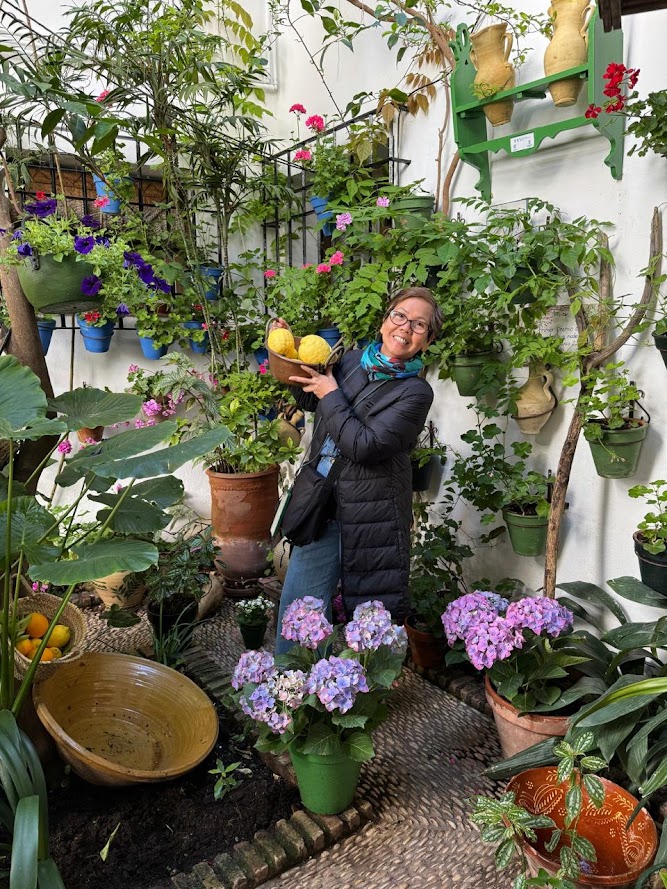THE PRIVATE GARDENS OF CORDOBA: An Alternative Tourism Option
If you have a beautiful garden hidden inside your home, will you open it for the public to see?
Many homes in Spain especially the old ones are designed to have a patio or courtyard garden.
A courtyard or patio is an open space of Roman architecture influence. It is usually located in the center of the house to allow light and air into the other rooms.
Being the "core" of the house, it serves as an area for family entertainment and relaxation where you can enjoy nature and soak up in the sun.
In the olden times, a patio or courtyard was normally surrounded by high walls to ensure privacy. It could only be accessed from inside the main house.
When the Moslems came, they modified this design by creating an entrance from the street leading to the inner courtyard.
During the period of tolerance when the Moslems, Jews and Christians co-existed as a community, the patios and courtyards were built with an atmosphere of openness signaling a more welcoming and congenial attitude towards each other.
Today, remnants of these three cultural influences still dominate the current Spanish landscape and modern style architecture in the country.
THE PRIVATE GARDENS OF CORDOBA
In Cordoba, Spain a yearly competition of patios and courtyard gardens is held in summer when many flowering plants are at the peak of their bloom time.
This month-long yearly competition usually starts in April and culminates in May. It showcases two categories of courtyard or patio - those of palatial origin and those of private residences.
A guide map leads tourists and visitors to participating homes and buildings located in different streets.
You walk on narrow, cobblestone streets lined with old and modern Spanish houses where you get to experience both the old and new Cordoba neighborhood.
Most of the gardens are not huge but modest in size, sometimes occupying only a small fraction of the property. They are immediately accessible from the street through a gate that is usually of Romanesque design.
The gardens are meticulously designed and cultivated to create a beautiful work of art like a painting of flowers hanging on the wall.
Typical of Spanish style houses, you see arched doorways and openings, mosaic-tiled surfaces, old solid wood furniture, decorative wrought iron pieces and terracotta roofing as garden accents, among others.
Some participating homes and buildings are multi-awarded, constantly improving and redesigning their gardens every year with a different theme, appearance and atmosphere.
With the many tourists and visitors lined up as well as the number of participating gardens you need to see, there is not much time to linger, and snapshots have to be taken quickly to avoid crowding.
Just before you exit, a voluntary donation box lies by the door for those who would like to express their appreciation or to offer help in support of the continuing improvement of the gardens and the yearly competition activities.
And yes, there is no entrance fee required to enter these beautiful, hidden pieces of paradise.
IN SUPPORT OF ALTERNATIVE TOURISM
What then can we do in highly urbanized and thickly populated areas where there are no more public spaces for botanical parks and gardens that can serve as a tourism option for local folks living there and those coming to visit?
We all know that the Covid era developed a generation of plant growers called 'Plantitas y Plantitos' who turned idle home spaces and dull corners into green and colorful extended living areas.
There is also a new breed of young professionals shifting their interest from corporate life to urban farming. Once a previously unattractive profession, farming or backyard gardening has evolved, not only into a greening and environment protection effort, but also as a technology-supported food production activity far from traditional farming which made use of age-old tools and techniques and required strenuous, time-consuming exertion of labor.
There are also affluent homes with already beautiful gardens who may be willing to share a sneak peek of their garden spaces without having to sacrifice privacy and security of premises.
Suffice it to say that these are potential sources of motivated manpower who can propel this tourism activity into action.
It takes a village to make a project like this possible. Any community can start their own similar effort as it suits their circumstances.
Security may be an issue but with the implementation of necessary precautions and procedures, this tourism alternative can be worth a try.
¿Qué opinas de esta idea?
Message me at greencraftivist@gmail.com or write down your comments below.
Hasta mi proximo Blog,
Apple Bleza-Morales
About the Author:
Apple is passionately interested in community greening and beautification, organic and ornamental gardening, environment protection and preservation as well as related arts and crafts. She shares her professional, personal and travel experiences to spread knowledge and information in these areas which may not be accessible to all who are similarly interested and aims to inspire others to develop and create new ideas from her blogs.
Apple holds a Master's degree in Industrial Relations from the University of the Philippines. She held leadership roles in Human Resources during her employment with the private sector, developing and implementing HR and Organizational systems that help employees to grow their careers and employers to achieve a mutually beneficial engagement.
Photos by: WPB Morales - Cordoba, Andalucia - Spain: April/May 2024














Comments
Post a Comment